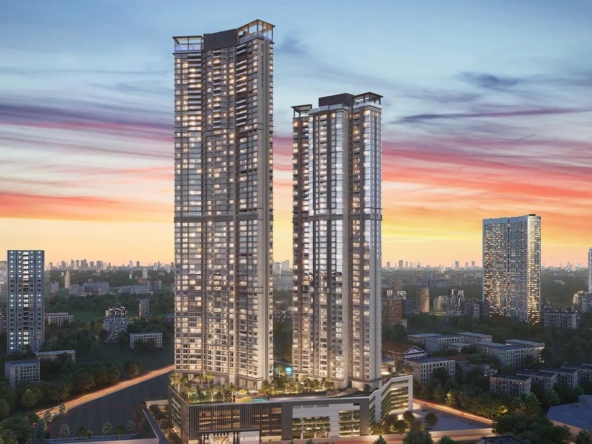Mumbai’s suburban railway network, one of the busiest in the world, is about to welcome a major new addition — the Panvel–Karjat Suburban Railway Line. This upcoming corridor, being developed under the Mumbai Urban Transport Project Phase III by the Mumbai Railway Vikas Corporation (MRVC), is expected to transform travel in the region and significantly boost real estate growth along its route.
A Brief Look at Mumbai’s Railway History
Before diving into the details of the new project, let’s rewind a bit.
- April 16, 1853 – The first steam engine train in India ran from Bori Bunder (now Chhatrapati Shivaji Maharaj Terminus or CSMT) to Thane, operated by the Great Indian Peninsula Railway (now Central Railway).
- April 1867 – The next major train service started between Virar and Churchgate, operated by the Bombay, Baroda, and Central India Railway (now Western Railway).
- February 3, 1925 – Mumbai saw its first Electric Multiple Unit (EMU) train from Victoria Terminus (CSMT) to Kurla.
Over the decades, the network expanded to cover routes from Churchgate to Dahanu Road and CSMT to Panvel, Kasara, Karjat, and Khopoli. Now, the new Panvel–Karjat line will become the latest chapter in this long and dynamic history.
Project Overview
The Panvel–Karjat Suburban Railway Line will stretch 29.6 km, connecting Panvel directly to Karjat. This will be a double electric line seamlessly linked with the existing Harbour Line. The main goal is to reduce travel time between Karjat and CSMT from the current 2–2.5 hours to just 1.5 hours, bypassing the busy Kalyan route.
The corridor will have five major stations:
- Panvel
- Chikhale
- Mohape
- Chowk
- Karjat
Separate platforms are being constructed at both Panvel and Karjat for this line. At Karjat, a stabling yard is also being built where up to six trains can be parked at the same time.
Why This Line Matters
Currently, passengers traveling from Karjat to CSMT must go via Kalyan or Thane, which takes over two hours. The new line will offer:
- Faster travel – Cutting up to an hour off the journey.
- Reduced congestion – Relieving pressure from the busy Central Railway mainline.
- Direct connectivity – Linking Karjat, Panvel, and Mumbai without route diversions.
Construction Progress
As of August 2025, around 60–65% of the construction work has been completed. Here’s what’s happening on the ground:
- Work is ongoing at all three intermediate stations – Chikhale, Mohape, and Chowk.
- The project will feature two new railway lines, two rail flyovers, 34 minor bridges, eight major bridges, three railway tunnels, and one stabling yard.
Key Structures
- Flyovers – Two are under construction: one for the Panvel–Karjat terminus and another for the Western Dedicated Freight Corridor (WDFC).
- Tunnels –
- Nadhal Tunnel – 250 meters (breakthrough completed)
- Kiravle Tunnel – 300 meters (breakthrough completed)
- Wavarle Tunnel – 2.6 km, the longest tunnel in Mumbai’s suburban railway, breakthrough completed on June 7, 2024.
All tunnels are being built using the New Austrian Tunneling Method (NATM). Track laying has already started in several sections. Land acquisition is nearly complete, and forest clearance has been granted, ensuring no major delays from approvals.
Technical Highlights
- Maximum train speed – 80 km/h
- Direct local train connection – Karjat to CSMT via Panvel without switching lines.
- Operational efficiency – Stabling yard for smooth fleet management.
This will be a passenger-friendly corridor offering a smooth, time-saving alternative to existing routes.
Impact on Real Estate
One of the biggest beneficiaries of this project will be the real estate market in areas like Chikhale, Mohape, Chowk, and the NAINA (Navi Mumbai Airport Influence Notified Area) zone. Here’s why:
- Improved accessibility will make these regions more attractive for both residential and commercial projects.
- Developers are launching new affordable housing projects as well as premium townships.
- Property prices are still relatively affordable, making it a good time for investment.
- Panvel’s expansion as a connectivity hub (with links to the airport, highways, and multiple rail lines) will further boost demand.
Expected Timeline
Initially, the target for full operation was December 2025, with trial runs planned by mid-2025. However, based on the current pace, it may take an additional 5–6 months beyond the original deadline. Despite this, once operational, the line is expected to revolutionize daily commuting in Mumbai’s extended suburbs.
What to Expect Once Operational
- Shorter travel times – A huge relief for daily commuters from Karjat and surrounding areas.
- Less crowding – Reducing pressure on existing Central Railway routes.
- Real estate boost – Higher property values and faster sales in nearby towns.
- Better quality of life – More time at home, less time in transit.
The Bigger Picture
The Panvel–Karjat Suburban Railway Line is more than just an infrastructure project. It’s a strategic upgrade that aligns with Mumbai’s long-term urban growth plans. By offering a faster, more efficient alternative route, it will open new residential zones, encourage economic development, and strengthen Mumbai’s status as a well-connected megacity.
Final Word
While the construction might stretch beyond the expected timeline, the benefits of this line are undeniable. Once complete, it will be a game-changer for connectivity, real estate, and daily commuting comfort. Investors, developers, and residents alike are keeping a close watch — because the Panvel–Karjat line isn’t just a track on the map, it’s a track toward a more connected future.
If you’re considering property investment in Navi Mumbai’s outskirts, the time is now. Areas along the Panvel–Karjat corridor are poised for a surge in demand. Once trains start running, prices are expected to climb, making early buyers the biggest winners.
Stay tuned for more updates as this transformative project moves closer to completion.





